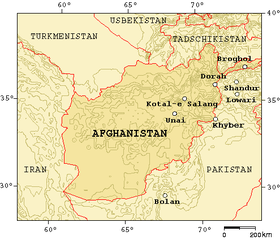बरोग़िल दर्रा
| बरोग़िल दर्रा | |
|---|---|
 अफ़ग़ानिस्तान के पहाद़ी दर्रे | |
| ऊँचाई | ३,७९८ मीटर (१२,४६० फ़ुट) |
| स्थान | वाख़ान गलियारा, चित्राल क्षेत्र, |
| पर्वतमाला | हिन्दु कुश |
| निर्देशांक | 36°53′N 73°21′E / 36.883°N 73.350°E |
बरोग़िल (Baroghil, بروغل) या बोरोग़िल या ब्रोग़िल या ब्रोग़ोल (Broghol, بروغول) हिन्दु कुश पर्वतमाला में स्थित एक पहाड़ी दर्रा है जो पाकिस्तान के ख़ैबर-पख़्तूनख़्वा प्रान्त के चित्राल क्षेत्र की मस्तुज वादी को अफ़ग़ानिस्तान के वाख़ान गलियारे से जोड़ता है। अन्य क्षेत्रीय दर्रों की तुलना में इसकी ऊँचाई कम है। साल में तीन महीने बर्फ़ग्रस्त होने से यह बन्द रहता है लेकिन बाक़ी के नौ महीने खुला होता है।[1] यहाँ के स्थानीय निवासी वाख़ी और किर्गिज़ हैं। अफ़ग़ानिस्तान की तरफ़ बरोग़िल दर्रे के चरणों में बसे गाँव का नाम सरहद (या 'सरहद-ए-ब्रोग़िल') है।[2] यहाँ १२,००० फ़ुट की औसत ऊँचाई पर स्थित एक आसान ढलान वाला ऊँचा मैदानी इलाक़ा है जिसे 'दश्त-ए-बरोग़िल' कहा जाता है और जिसका प्रयोग स्थानीय निवासी मवेशी चराने के लिए करते हैं।[3]
नाम का उच्चारण[संपादित करें]
'बरोग़िल' में 'ग़' अक्षर के उच्चारण पर ध्यान दें क्योंकि यह बिना बिन्दु वाले 'ग' से ज़रा भिन्न है। इसका उच्चारण 'ग़लती' और 'ग़रीब' शब्दों के 'ग़' से मिलता है।
इतिहास में[संपादित करें]
इतिहास में दरकोट दर्रा आमू दरिया क्षेत्र से सिन्धु नदी क्षेत्र तक आने-जाने का सबसे छोटा मार्ग हुआ करता था। १९वीं सदी में जब भारतीय उपमहाद्वीप पर ब्रिटिश राज था और मध्य एशिया में रूसी साम्राज्य का ज़ोर था तो भारत के अंग्रेज़़ हुकुमरानों को यह डर था कि रूसी सेना कभी यासीन का मार्ग लेकर भारत पर क़ब्ज़ा करने की कोशिश कर सकती है। इसलिए उन्होनें अफ़ग़ानिस्तान को वाख़ान क्षेत्र पर अपना अधिकार जमा लेने के लिये उकसाया ताकि रूसी क्षेत्र और भारतीय क्षेत्र में सीधा सम्पर्क न हो।[4][5]
इन्हें भी देखें[संपादित करें]
सन्दर्भ[संपादित करें]
- ↑ Proceedings of the Royal Geographical Society and Monthly Record of Geography, Volume 1, Royal Geographical Society (Great Britain), pp. 111, Edward Stanford, 1879, ... Baroghil Pass, which leads from the Mastuj stream, the name applied to the upper portion of the Kunar, to Sarhadd, within the Upper Oxus Basin, is an easy route across an elevated table-land ...
- ↑ The encyclopaedia of Islām: a dictionary of the geography, ethnography and biography of the Muhammadan peoples, International Association of Academies, E. J. Brill ltd., 1934, ... The Afghan part of Wakhan contains seven districts, namely from west to east: Warg, Urgand, Khandud, Kal'a-yi Pandja, Baba-Tangi, Nirs-wa-Shalak and Sarhadd (this last named village is at the foot of the Baroghil pass at a height of 11,350 feet) ...
- ↑ Proceedings of the Royal Geographical Society and Monthly Record of Geography, Volume 1, Royal Geographical Society (Great Britain), pp. 111, Edward Stanford, 1879, ... The height of the Dasht-i-Baroghil is estimated at 12,000 feet. In summer it is covered with rich pasture, and is a favourite grazing-ground for the cattle from the Wakhan Valley, on the Oxus side ...
- ↑ India China Boundary In Kashmir Archived 2014-03-15 at the वेबैक मशीन, Hriday Nath Kaul, Gyan Publishing House, 2003, ISBN 9788121208260, ... It then only remained for Russia to strike across the low pass of Ishkoman to be in Yasin and down to the Indus. Kashmir already was within 40 or 50 miles of the Pamirs from Emit village ...
- ↑ The Pundits: British Exploration Of Tibet And Central Asia, Derek J. Waller, pp. 161, University Press of Kentucky, 2004, ISBN 9780813191003, ... Although the Indian government continued to be concerned about Russian influence over Kashgar, particularly after the conquest of Kokand in 1876, strategic concerns shifted to the Baroghil and other passes over the Hindu Kush. Biddulph's report on his excursion to the Baroghil pass gave the clear impression that an army, even equipped with artillery, could be moved over it with ease ...
